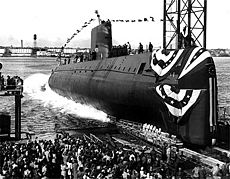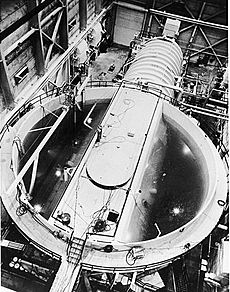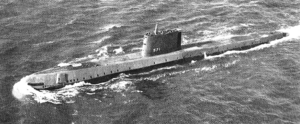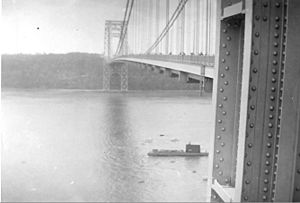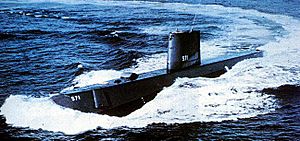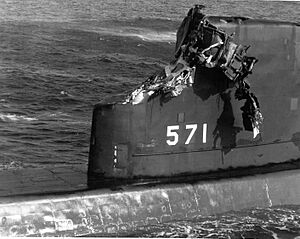USS Nautilus (SSN-571) facts for kids
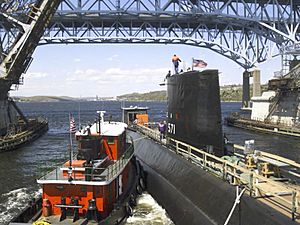
The retired USS Nautilus heads home on 8 May 2002, after preservation by the Electric Boat Division
|
|
Quick facts for kids Class overview |
|
|---|---|
| Builders: | General Dynamics |
| Operators: | |
| Preceded by: | Tang class |
| Succeeded by: | USS Seawolf |
| Built: | 1952 |
| In commission: | 1954–1980 |
| History | |
| Name | Nautilus |
| Namesake | Jules Verne's "Nautilus" submarine |
| Awarded | 2 August 1951 |
| Builder | General Dynamics |
| Laid down | 14 June 1952 |
| Launched | 21 January 1954 |
| Sponsored by | Mamie Eisenhower (First Lady of the United States) |
| Completed | 22 April 1955 |
| Commissioned | 30 September 1954 |
| Decommissioned | 3 March 1980 |
| Stricken | 3 March 1980 |
| Status | Museum ship |
| General characteristics | |
| Type | Nuclear submarine |
| Displacement | |
| Length | 320 ft (97.5 m) |
| Beam | 28 ft (8.5 m) |
| Draft | 26 ft (7.9 m) |
| Installed power | 13,400 hp (10,000 kW) |
| Propulsion | STR nuclear reactor (later redesignated S2W), geared steam turbines, two shafts |
| Speed | 23 kn (43 km/h; 26 mph) |
| Complement | 13 officers, 92 enlisted |
| Armament | 6 torpedo tubes |
|
U.S.S. Nautilus (Nuclear Submarine)
|
|
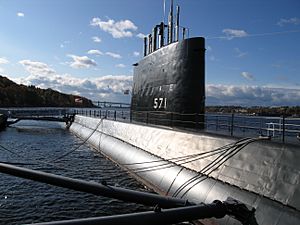
USS Nautilus docked at the Submarine Force Library and Museum
|
|
| Lua error in Module:Location_map at line 420: attempt to index field 'wikibase' (a nil value). | |
| Location | Groton, Connecticut |
| Built | 1952-1955, (commissioned 1954) |
| Architect | General Dynamics Corporation |
| NRHP reference No. | 79002653 |
| Significant dates | |
| Added to NRHP | 16 May 1979 |
| Designated NHL | 20 May 1982 |
The USS Nautilus (SSN-571) was a super important submarine! It was the world's very first submarine powered by a nuclear reactor. This amazing ship also made history by being the first submarine to travel completely underwater across the North Pole on August 3, 1958.
The Nautilus got its name from the famous fictional submarine in Jules Verne's classic 1870 science fiction book, Twenty Thousand Leagues Under the Sea. Another Nautilus|SS-168 also served bravely during World War II.
Building the Nautilus was approved in 1951. Construction started in 1952, and it was launched in January 1954. Mamie Eisenhower, the wife of President Dwight D. Eisenhower, was its sponsor. The submarine officially joined the United States Navy in September 1954 and was ready for duty in 1955.
Because it used nuclear power, the Nautilus could stay underwater much longer than older submarines that ran on diesel fuel. It broke many records in its early years and explored places submarines had never reached before. The information learned from its operations helped make even better submarines in the future.
The Nautilus was taken out of service in 1980. In 1982, it was named a National Historic Landmark. Today, you can visit it as a Museum ship at the Submarine Force Library and Museum in Groton, Connecticut. About 250,000 people visit it every year!
Contents
Building the First Nuclear Submarine
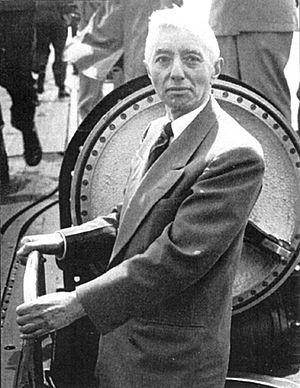
The idea for the first nuclear submarine began in March 1950. In July 1951, the U.S. Congress gave permission to build this special submarine for the U.S. Navy. Captain Hyman G. Rickover, often called the "Father of the Nuclear Navy," planned and watched over its construction.
On December 12, 1951, the Navy announced the submarine would be named Nautilus. It was the fourth U.S. Navy ship to have this name. The submarine was given the hull number SSN-571.
Designers looked at the advanced shape of the German Type XXI U-boat from World War II for ideas. This German submarine had a smooth, streamlined shape. This design helped it move faster and more efficiently underwater. Its new way of performing underwater influenced how submarines were built all over the world.
The building of the Nautilus started on June 14, 1952, at General Dynamics' Electric Boat Division in Groton, Connecticut. Harry S. Truman was there for the ceremony. It was officially named and launched into the Thames River on January 21, 1954. Mamie Eisenhower was the sponsor. The Nautilus was officially put into service on September 30, 1954, with Commander Eugene P. Wilkinson in charge.
The Nautilus was powered by a special nuclear reactor called the Submarine Thermal Reactor (STR). This reactor was later called the S2W reactor. It was a pressurized water reactor made by Westinghouse Electric Corporation. Nuclear power was perfect for submarines because it doesn't create exhaust and doesn't need air to run. This design became the basis for almost all U.S. nuclear-powered submarines and surface ships. Other countries also used this design for their naval nuclear power.
Setting Sail with Nuclear Power
After being put into service, the Nautilus stayed at the dock for more building and testing. On January 17, 1955, at 11:00 a.m., Commander Eugene P. Wilkinson gave the order to set sail. As the submarine moved away from the pier, there was a loud noise from one of the gears. Commander Wilkinson decided to continue the journey, even with many reporters watching.
Engineers quickly fixed a loose pin in the noisy gear. Soon, the Nautilus was back on full steam power. As it sailed down the Thames River into Long Island Sound, a signal was sent to an escort tug: "Underway on nuclear power."
On May 10, the Nautilus began its first long test trip. It traveled 1,100 nautical miles (about 2,037 kilometers) from New London to San Juan, Puerto Rico. It covered 1,200 nautical miles (about 2,222 kilometers) in less than 90 hours, staying underwater the whole time. This was the longest and fastest underwater journey ever made by a submarine at that time.
From 1955 to 1957, the Nautilus helped scientists learn more about how fast submarines could go and how long they could stay underwater. These discoveries made many of the anti-submarine warfare methods from World War II outdated. Things like radar and anti-submarine planes were not as effective against a submarine that could move quickly, change depth, and stay submerged for a very long time.
On February 4, 1957, the Nautilus had traveled 60,000 nautical miles (about 111,120 kilometers). This was the same distance as the fictional Nautilus in Jules Verne's book. In May, it went to the Pacific Coast for exercises. These exercises helped the Pacific Fleet learn about the amazing abilities of nuclear submarines.
The Nautilus returned to New London, Connecticut, on July 21. On August 19, it left again for its first trip of 1,200 nautical miles (about 2,222 kilometers) under the polar ice. After that, it went to the Eastern Atlantic for NATO exercises. It also visited British and French ports, where defense experts from those countries inspected it. It arrived back in New London on October 28.
Journey to the North Pole: Operation Sunshine
President Eisenhower asked the U.S. Navy to try to send a submarine under the North Pole. This was to show off American technology after the Soviet Union launched Sputnik. On April 25, 1958, the Nautilus set off for the West Coast with Commander William R. Anderson in charge. It stopped in San Diego, San Francisco, and Seattle.
On June 9, it began its historic journey to the North Pole, called "Operation Sunshine." On June 19, it entered the Chukchi Sea but had to turn back because of thick ice in the shallow waters. On June 28, it arrived at Pearl Harbor to wait for better ice conditions.
By July 23, it was heading north again. On August 1, it submerged in the Barrow Sea Valley. At 11:15 PM EDT on August 3, it became the first watercraft to reach the geographic North Pole! The submarine could navigate in these extreme northern areas thanks to a special Inertial Navigation System. This system was first tested on other ships in 1957.
After reaching the North Pole, the Nautilus continued its journey. It surfaced northeast of Greenland after 96 hours and 1,590 nautical miles (about 2,945 kilometers) under the ice. It had completed the first successful underwater trip around the North Pole. Scientists, including Dr. Waldo Lyon, helped plan the technical details of this mission. Dr. Lyon even went along as the chief scientist and ice pilot.
Navigating under the Arctic ice was very challenging. Regular compasses don't work well above 85°N. A special gyrocompass was installed just before the trip. Commander Anderson even thought about using torpedoes to blast a hole in the ice if the submarine needed to surface.
The hardest part of the journey was in the Bering Strait. The ice there went as deep as 60 feet (about 18 meters) below the sea. During the first try, there wasn't enough space between the ice and the seabed. On the second try, the submarine found a known channel near Alaska to pass through.
This trip under the ice cap was a huge success for America. The Soviets had recently launched Sputnik, but they didn't have their own nuclear submarine yet. President Eisenhower announced the journey and said that one day, nuclear cargo submarines might use this route for trade.
As the Nautilus sailed south from Greenland, Commander Anderson was flown by helicopter to Washington, D.C. On August 8, at a White House ceremony, President Eisenhower gave him the Legion of Merit award. He also announced that the crew had earned a Presidential Unit Citation, a very high honor.
The next stop for the Nautilus was the Isle of Portland, England. There, the American Ambassador presented the crew with the Unit Citation. This was the first time this award was given during peacetime. The submarine then crossed the Atlantic and arrived back in New London, Connecticut, on October 29.
Adventures and Missions
The Nautilus went into the Portsmouth Naval Shipyard in Kittery, Maine, for its first major check-up from May 28, 1959, to August 15, 1960. After this, the crew practiced their skills again. On October 24, it left New London for its first mission with the Sixth Fleet in the Mediterranean Sea. It returned home on December 16.
For most of its career, the Nautilus was part of Submarine Squadron 10 (SUBRON 10) in New London, Connecticut. It would dock next to the submarine tender USS Fulton (AS-11). There, skilled workers from the Fulton would help with maintenance and repairs.
The Nautilus operated in the Atlantic Ocean. It tested new ways to improve anti-submarine warfare and took part in NATO exercises. In October 1962, it helped with the naval blockade of Cuba. Then, in August 1963, it went on a two-month trip to the Mediterranean. After returning, it joined fleet exercises until it went for its second major check-up on January 17, 1964.
On May 2, 1966, the Nautilus returned to its homeport to continue missions with the Atlantic Fleet. That month, it reached an amazing milestone: 300,000 nautical miles (about 555,600 kilometers) traveled! In August 1967, it returned to Portsmouth for another year of maintenance. During an exercise on November 10, 1966, it accidentally bumped into the aircraft carrier USS Essex while at a shallow depth. After repairs, it continued exercises. It returned to New London in December 1968 and stayed with Submarine Squadron 10 for most of its remaining time in service.
On April 9, 1979, the Nautilus began its final journey from Groton, Connecticut, led by Commander Richard A. Riddell. It arrived at the Mare Island Naval Shipyard in Vallejo, California, on May 26, 1979. This was its last day sailing. It was officially taken out of service on March 3, 1980.
Learning from Design Challenges
Towards the end of its service, the Nautilus had a problem. Its hull and sail vibrated a lot. This made its sonar system not work well at speeds over 4 knots. This meant it could be more easily detected by enemy sonar. Engineers learned important lessons from this issue. These lessons helped them design quieter and more effective nuclear submarines in the future.
Special Awards and Honors
| Presidential Unit Citation with Operation Sunshine clasp |
National Defense Service Medal |
A Top Honor: The Presidential Unit Citation
For outstanding achievement in completing the first voyage in history across the top of the world, by cruising under the Arctic ice cap from the Bering Strait to the Greenland Sea.
During the period 22 July 1958 to 5 August 1958, USS Nautilus, the world's first nuclear powered ship, added to her list of historic achievements by crossing the Arctic Ocean from the Bering Sea to the Greenland Sea, passing submerged beneath the geographic North Pole. This voyage opens the possibility of a new commercial seaway, a Northwest Passage, between the major oceans of the world. Nuclear-powered cargo submarines may, in the future, use this route to the advantage of world trade.
The skill, professional competency and courage of the officers and crew of Nautilus were in keeping with the highest traditions of the Armed Forces of the United States and the pioneering spirit which has always characterized the country.
To celebrate the first underwater journey under the North Pole, all Nautilus crewmembers who were on that trip can wear a special Presidential Unit Citation ribbon. This ribbon has a gold block letter N on it, as shown in the image above.
Visiting the Nautilus Museum
The Nautilus was named a National Historic Landmark by the United States Secretary of the Interior on May 20, 1982.
In 1983, it was named the official state ship of Connecticut. After a big renovation at the Mare Island Naval Shipyard, the Nautilus was towed back to Groton. It arrived on July 6, 1985, under the command of Captain John Almon. On April 11, 1986, it opened to the public as part of the Submarine Force Library and Museum.
Today, the Nautilus is a museum about submarine history. It is managed by the Naval History and Heritage Command. In 2002, it had a five-month preservation project at Electric Boat, costing about $4.7 million. This would be about $7.9 million in 2025.
The museum attracts about 250,000 visitors each year. You can tour the front two sections of the submarine. An automated system guides you through the tour.
On September 30, 2004, the Nautilus celebrated its 50th anniversary. There was a ceremony with a speech from Vice Admiral Eugene P. Wilkinson, its first Commanding Officer. The ship was also named an American Nuclear Society National Nuclear Landmark.
In March 2022, the Nautilus began another restoration project. This work included cleaning and painting the hull, installing new top decks, and upgrading the interior lights and electrical systems. This restoration cost US$36 million.
See also
 In Spanish: USS Nautilus (SSN-571) para niños
In Spanish: USS Nautilus (SSN-571) para niños
- USS Skate (SSN-578) (the first submarine to surface at the North Pole)
- List of museum ships
- Submarine Cargo Vessel


